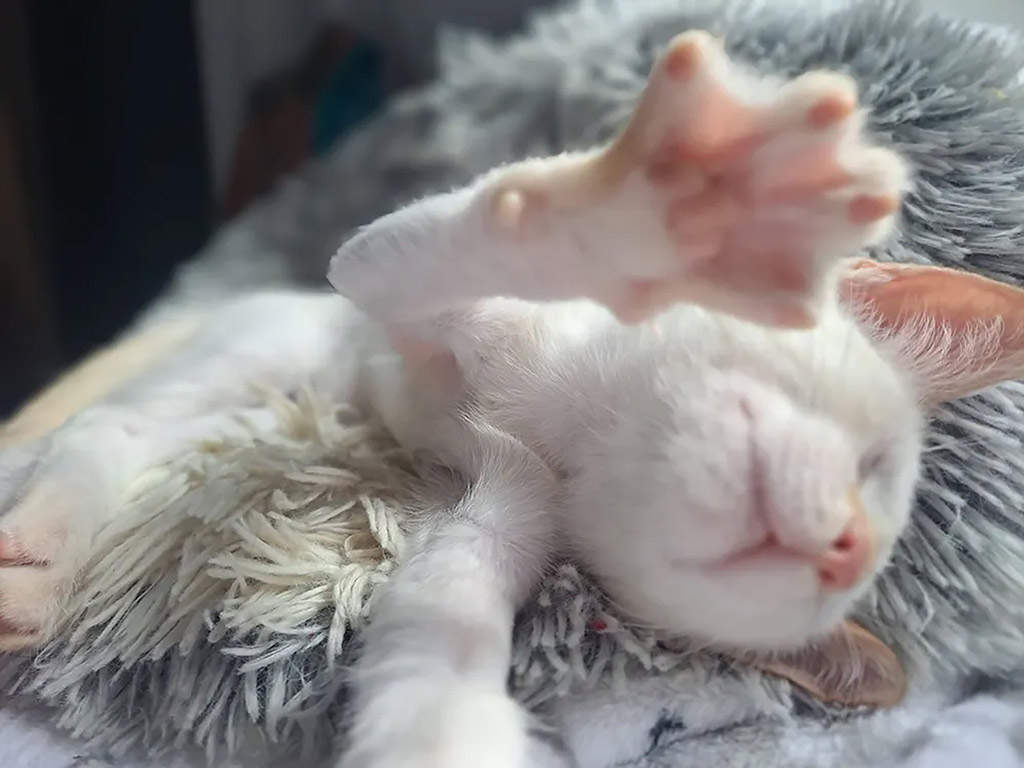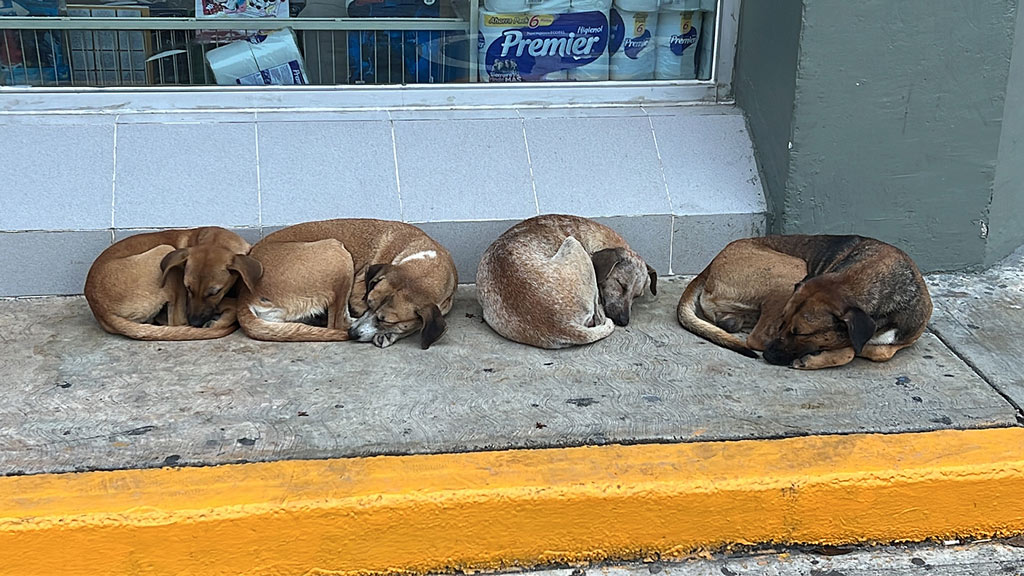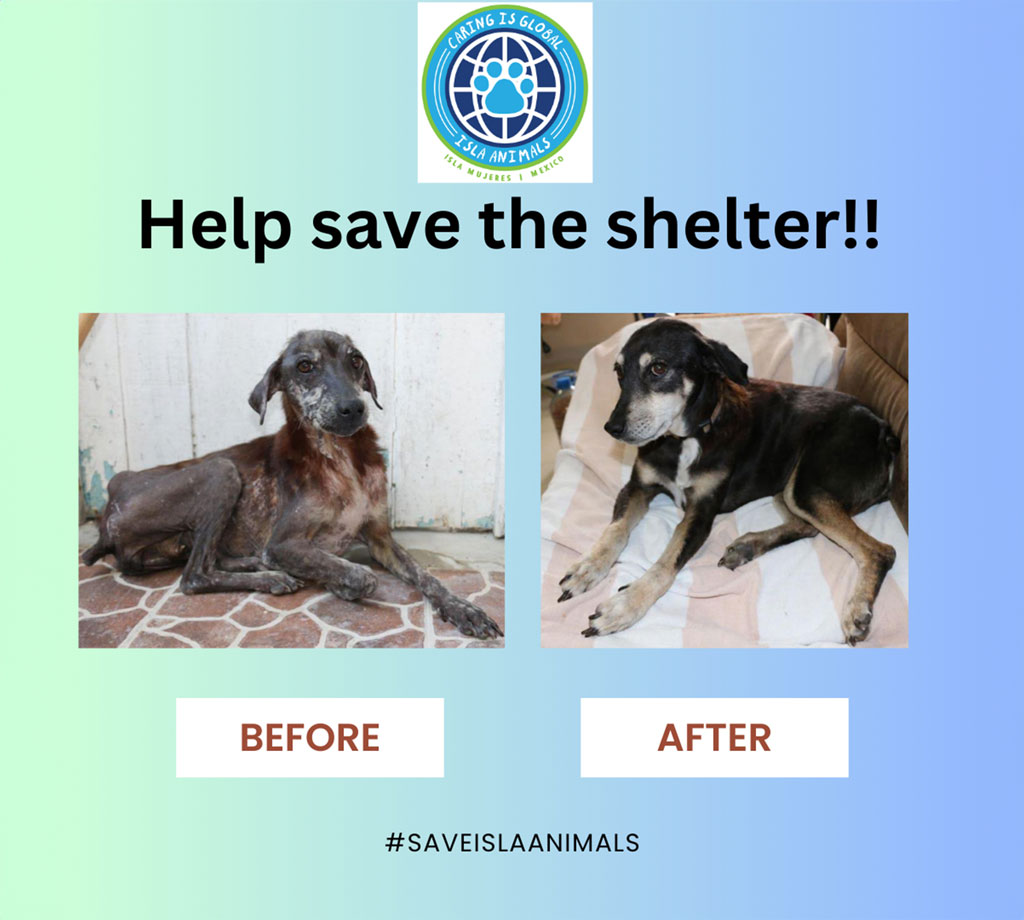This is the story of a situation that had to change. If animals could talk, the animals of Mexico would be screaming. They are starved, plagued with parasites and illness. They are neglected and unwanted, and powerless to help themselves. “There are things I could tell you.” Says Alison Sawyer. “But I don’t want to break your heart. I’m asking for your support to continue to do something to stop this cycle of suffering.”
Alison Sawyer moved to Isla Mujeres, Mexico, in 1999 for the landscape, weather, and culture and to continue her career as a potter. Unfortunately, the scenery she so admired was tainted by the sad existence of the starving, wounded, and neglected dogs and cats on the island and the mainland nearby. She began by helping other concerned foreigners protect and rescue dogs and puppies. “The islanders were not to blame,” explained Sawyer. “There was no vet on the island and therefore no way to spay and neuter the animals or buy the supplies needed to keep their dogs healthy.”

After years of unchecked breeding, there were dogs and cats everywhere. I started by taking in puppies,” said Sawyer. “The Islander’s dogs would have puppies who would be entertaining until the mother stopped feeding and cleaning up after them. I mean, how many dogs can one family care for?” When the puppies were weened, they were put in a box and abandoned in an empty lot or in the jungle.
By 1999 there were animals everywhere that fit into three categories, pets, street dogs, and wild dogs. By island standards, “pet” was a loose term. The dog simply hung around a certain house where the owners would accept them, throwing leftovers in the yard and hoping for a little security in return.
Some puppies stayed in the jungle and turned wild, which meant they stayed away from humans completely. Some puppies would stay where there was food and become street dogs who ate garbage and hung out around restaurants, often pelted by stones as an annoying nuisance. This was the situation when Alison Sawyer arrived, and the local solution was unacceptable. Hotels would put out poison to keep these unwanted, sad-looking animals away from their guests, and the government would round up any dogs they could catch and electrocute them.
Sawyer had a half-acre of land where she built her house with a spare room over her garage. That is where she started putting the puppies she found or were brought to her. She divided the space with cinderblocks in an effort to keep the litters separated or to keep the pups isolated according to size. She found some of these puppies’ homes or sent them to friends in the US and Canada. But many of them grew up at her house, and on top of that, people started to bring her abandoned dogs, quickly increasing her numbers. “The most I ever had,” said Sawyer, “was 65 dogs. The yard was divided up into as many different spaces as we could find materials to create barriers.
So, this was the beginning, twenty-three years ago. The neighbors complained, and the government resented the interference in a problem they thought they already had a solution for. Concerned tourists started coming to what was now referred to as her rescue, called Isla Animals, which Sawyer had registered as a 501C3 non-profit in the US. Soon the rescue was put in a travel brochure as a place of interest to visit on vacation, so when tourists showed up, she put them to work cleaning and walking dogs.

“It’s amazing how much I didn’t know. I asked; I read, but these animals had so many problems: no vaccines, dewormers, tick, flea, or heartworm prevention. The mange and wounds were overwhelming as these poor, hungry animals had often been fighting for food or territory before I would get them. They were a mess.” Sawyer explained.
Donations and concerns for these dogs and cats grew after Sawyer created a website. The island finally got a veterinarian who helped Isla Animals sponsor free spay and neuter campaigns. As word spread, tourists would volunteer and bring supplies. Once a fishing village, Isla Mujeres was rapidly becoming a major vacation destination.
In 2015 the local government recognized the difference that Isla Animals was making and gave them a space to work out of. “It was a lifesaver, my house was not big enough, and there was so much to do,” said Sawyer.
The rescue did more every year, eventually spaying and neutering up to 4,000 cats and dogs a year and rehoming 300 to 400 animals in the same amount of time. With the help of volunteers and more donations, the group extended their services to as many places as they had the time and money to help.
“It was exhausting and wonderful, heartbreaking and exhilarating,” Alison said. “I had never been as totally immersed in a cause in my life; I didn’t want to do anything else.”
Then the worst happened. The government reclaimed the space that had been home to Isla Animals for 8 years. The rescue was given 3 weeks to vacate. The team was devastated. “I think we did our Job too well,” said Trina Noakes, the new director of operations since 2018. The government changes so often, and the new people in charge haven’t seen the problem. We did all the work for them because their solutions were unacceptable.”
So now Isla Animals is as homeless as the animals they are trying to save. They have had to cut the amount of service and rescue they were doing by ninety percent. They’ve had to cancel their spay and neuter programs, and they have had to say no to animals in need.
Luckily a piece of land has been donated to the rescue. It’s in the jungle on the outskirts of Cancun.
But it has nothing, no water, no sewage, and no electricity. “We have used the money we put aside for spay and neuter campaigns to clear the land, build a fence and dig a well and septic system. That is where we are now,” said Trina Noakes. “We have plans but have to raise money to make it happen. We are excited to work in a place that no one can take from us, but we are not doing our work in the meantime. What do you do when three different people ask you to take in 3 different abandoned litters of puppies on the same day? Not only do we not have the space, but we are spending all of our time and money relocating; it’s heartbreaking.”
This rescue and the volunteers that work with them are known for their unwavering support of the animals and communities they serve. They only work to help animals, to make change, and to educate. No one is paid for administration; only a small group of local women are paid to care for the dogs at the rescue. There is so much need, these animals starve and suffer every day, and this can be fixed with time, money, and devotion.
Isla Animals has created a gofundme to raise money to build on the new land. Please help them get back to work saving animals.
Along with their website https://www.islaanimals.org you can follow them on any of the sites below.
https://www.facebook.com/IslaAnimals
https://www.instagram.com/islaanimals/
https://www.tiktok.com/@islaanimalsrescue
https://www.youtube.com/@IslaAnimalsRescue







